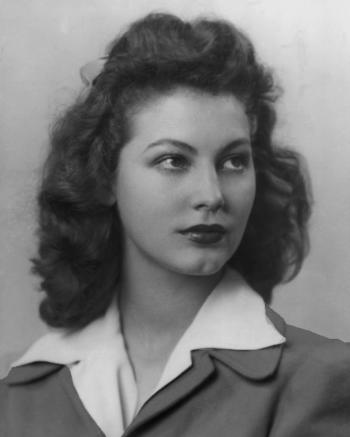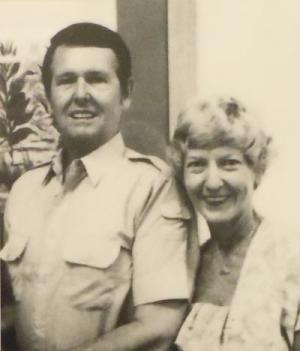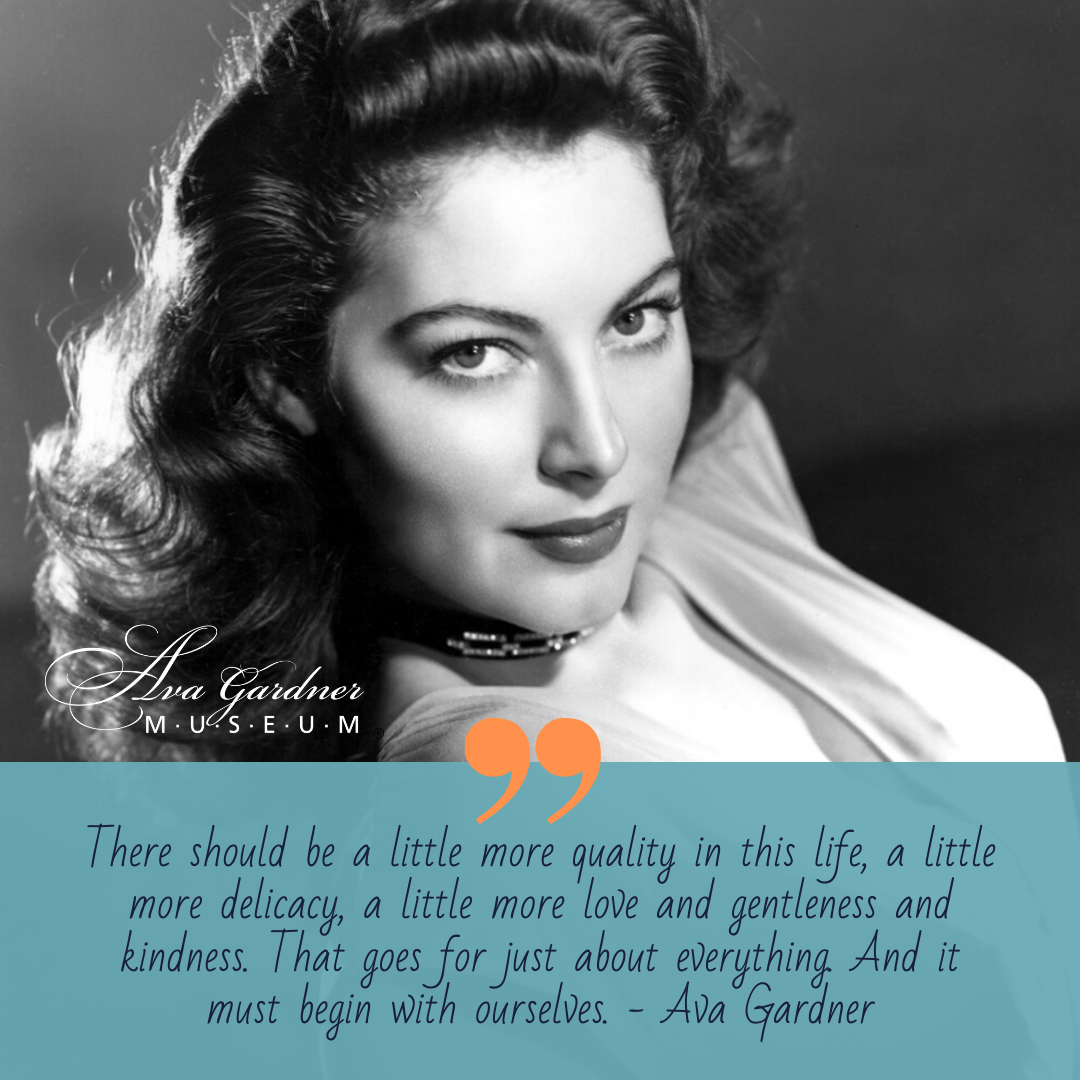About Us: Museum History
It started with a kiss…
The Ava Gardner Museum started with a kiss. More specifically, the large holdings of memorabilia and artifacts amassed over 40 years by Dr. Thomas and Lorraine Banks which form the bedrock of our collection all began with a kiss.
 In 1941, Ava Gardner was a freshman secretarial student at Atlantic Christian College (now Barton College) in Wilson, North Carolina. A precocious, 12-year-old boy named Tommy lived near campus. Each afternoon, while Ava and classmates waited for their rides home, Tommy and his friends would ride their bikes to campus to tease the young college students. One day, as Tommy whizzed by Ava calling out, “Hey, Girlfriend!”, she decided to jokingly retaliate. She suddenly jumped up from her seat and chased him down. Once she caught him, she planted a big kiss on his cheek, right in front of his friends. While Tommy was initially embarrassed by the incident, he never forgot the pretty, playful young college student responsible for his first kiss.
In 1941, Ava Gardner was a freshman secretarial student at Atlantic Christian College (now Barton College) in Wilson, North Carolina. A precocious, 12-year-old boy named Tommy lived near campus. Each afternoon, while Ava and classmates waited for their rides home, Tommy and his friends would ride their bikes to campus to tease the young college students. One day, as Tommy whizzed by Ava calling out, “Hey, Girlfriend!”, she decided to jokingly retaliate. She suddenly jumped up from her seat and chased him down. Once she caught him, she planted a big kiss on his cheek, right in front of his friends. While Tommy was initially embarrassed by the incident, he never forgot the pretty, playful young college student responsible for his first kiss.
The following academic year, Tommy wondered what happened to his “girlfriend” when she did not return to campus for her sophomore classes. He soon found the answer while flipping through an issue of The Wilson Daily Times. Right there in the newspaper was an image of Ava Gardner followed by a “local girl makes good” announcement stating that she had signed a studio contract and was off to Hollywood. Stunned that he actually knew someone who was going to be in pictures, Tommy excitedly cut out the article as a memento and tucked it away in a shoebox. From then on, his hobby of collecting began – saving every newspaper article, fan magazine, and print advertisement featuring Ava Gardner that he could find.
As Tommy grew into Thomas, his fascination with Ava Gardner never waned. While a student at the College of William and Mary in Williamsburg, Virginia, Thomas sent a fan letter to Ava in Hollywood asking her to become the “sweetheart” of his fraternity, Phi Kappa Tau. After graciously accepting, she sent autographed pictures to all of the new pledges and even began a regular correspondence with Thomas.
After college graduation, Thomas briefly served in the Navy as an intelligence officer. He then headed to Hollywood where he found a position in film publicity with Columbia. He even had the opportunity to work on Ava’s 1951 movie My Forbidden Past costarring Robert Mitchum and Melvyn Douglas. Despite the excitement of life in the entertainment world, Thomas soon realized publicity was not for him long-term, so he went back to school and earned a PhD in psychology.
In 1960, Thomas married Lorraine, and the couple moved to Pompano Beach, Florida where they both began careers in education with the Broward County School System. Over time, Lorraine became just as captivated with Ava Gardner as her husband, and the two started traveling the world collecting memorabilia and artifacts to add to their collection.
 Thomas and Lorraine had a unique position among enthusiastic superfans, they were able to become friends with the person who inspired their hobby. While visiting Ava at her London apartment in 1978, the Banks discussed the possibility of donating their collection to a professional or educational institution. Ava had a much better idea. She thought their massive compilation of items should belong in her home state of North Carolina, thus beginning the genesis of what would become the Ava Gardner Museum.
Thomas and Lorraine had a unique position among enthusiastic superfans, they were able to become friends with the person who inspired their hobby. While visiting Ava at her London apartment in 1978, the Banks discussed the possibility of donating their collection to a professional or educational institution. Ava had a much better idea. She thought their massive compilation of items should belong in her home state of North Carolina, thus beginning the genesis of what would become the Ava Gardner Museum.
At the same time the Banks were contemplating the future of their collection, a young columnist and community journalist named Doris Rollins Cannon was campaigning for North Carolina to finally celebrate their native daughter, Ava Gardner.
Doris Cannon, the article that sparked a museum.
Born in the mountains of North Carolina, Doris was a young widow with three small children when she relocated to Raleigh to pursue a career in journalism. After completing courses at NC State University, she landed a job in 1970 with The Smithfield Herald.
Having been an avid film fan since childhood, Doris knew that Ava spent her formative years in Eastern North Carolina. After researching the story of her remarkable rise from farm girl to celebrated actress, Doris wondered why there was no street named for Ava or other public recognition for her in Smithfield. By the late 1970s, she decided to take action. In her March 1978 newspaper column entitled, “Isn’t It Time That Smithfield Saluted Ava?”, Doris wrote an impassioned plea for civic leaders to honor Ava Gardner and her ties to the area.
Fate intervened when, also in 1978, the Banks contacted The Smithfield Herald requesting copies of Ava photos for their collection. Within days of receiving the letter, the superfans from Florida and the community journalist from North Carolina were speaking for the first time over the phone and planning an Ava Gardner exhibit in Smithfield.
For three days in 1979, the Banks displayed portions of their Ava Gardner memorabilia in downtown Smithfield. The following year, the couple returned to Johnston County and setup another temporary exhibit, this time with even more artifacts. With encouragement from Doris, the Banks purchased the old Brogden School Teacherage building, where Ava lived from ages 2 to 13. In 1981, the Banks permanently moved their vast collection to the Teacherage and opened the first Ava Gardner Museum. For the next eight years, the Banks along with the assistance of their first docent, Doris, operated the museum each summer as a seasonal attraction.
The Brogden Museum Years at the Teacherage
 In May 1985, during her last visit home to North Carolina, Ava and three of her sisters, Bappie, Elsie Mae, and Myra, drove out to the farm where they were born in Grabtown. After seeing the farmhouse, they headed to the nearby community of Brogden to see the Teacherage. The Ava Gardner Museum had not yet opened for the summer season, so the door was locked when they arrived. When her sisters suggested they call someone to let them inside, Ava said no because she did not want to inconvenience anyone. She simply remarked to her sisters, “I know what’s in there, I lived it.”
In May 1985, during her last visit home to North Carolina, Ava and three of her sisters, Bappie, Elsie Mae, and Myra, drove out to the farm where they were born in Grabtown. After seeing the farmhouse, they headed to the nearby community of Brogden to see the Teacherage. The Ava Gardner Museum had not yet opened for the summer season, so the door was locked when they arrived. When her sisters suggested they call someone to let them inside, Ava said no because she did not want to inconvenience anyone. She simply remarked to her sisters, “I know what’s in there, I lived it.”
In August 1989, Thomas suffered a massive stroke at the museum and died a few days later. While officially buried in the Banks family plot in Wilson, NC, Lorraine also lovingly scattered some of his ashes at the Teacherage in recognition of his life’s work in devotion to the Ava Gardner Museum. Five months later on January 25, 1990, Ava Gardner passed away in her London home from complications with pneumonia.
With the 1990 summer season fast approaching and still grieving the loss of her beloved husband, Lorraine contacted civic leaders in Johnston County with a proposal. If they agreed to maintain a permanent museum in Smithfield, she would generously donate the entire Banks collection to the town. Needless to say, the Town of Smithfield enthusiastically agreed to her terms.
From storefronts to a newly designed museum
In 1991, the Teacherage was sold and, in the spring, the Banks collection was relocated to a rented storefront in Smithfield. The Ava Gardner Museum was incorporated in 1996 as a 501 (c) 3 to properly manage and care for the collection. In August 1999, the board of directors invested in a permanent museum home by purchasing and extensively renovating a 6,400 square foot building in downtown Smithfield, and, in October 2000, the new Ava Gardner Museum opened its doors.
Doris Rollins Cannon continued to be a fierce advocate and unwavering champion of the Ava Gardner Museum. In 2001, she turned her decades of research into the book “Grabtown Girl” – the official guide to Ava Gardner’s early life in North Carolina. She served as a docent, member of the foundation board, lobbyist, and regular volunteer for the museum until passing away from cancer in 2015.
Through generous donations and strategic acquisitions, the Town of Smithfield and the Ava Gardner Museum, have continued to build the collection that began in 1941 with a kiss from young Ava. Bill Wilson, a staunch museum supporter from the very beginning, donated an extensive collection of film posters and lobby cards for the new museum in 2000. The family of Dutch artist Bert Pfeiffer, whose paintings of Ava Gardner were in the Banks collection, donated his collection of still photography, as well as additional portraits of Ava painted by Pfeiffer. Individuals from Ava’s inner circle like Carmen Vargas and Andrew Anthos have donated assorted items. Members of the Gardner family have also gifted and loaned artifacts to the museum. Additionally, the Gardner family continues to be an invaluable resource in the museum’s ongoing efforts to share Ava’s story. With a vast collection and thousands of annual visitors from all over the world, the museum has become the definitive source for preserving and interpreting the remarkable life and lasting legacy of Ava Gardner.
See the detailed timeline with dates and milestones for the Ava Gardner Museum.









HOME | ABOUT | VISIT THE MUSEUM | GIFT SHOP | CONTACT




